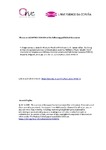Mostrar o rexistro simple do ítem
Evolving military broadband wireless communication systems: WiMAX, LTE and WLAN
| dc.contributor.author | Fraga-Lamas, Paula | |
| dc.contributor.author | Castedo, Luis | |
| dc.contributor.author | Morales-Méndez, Antonio | |
| dc.contributor.author | Camas-Albar, J. M. | |
| dc.date.accessioned | 2024-02-01T15:52:34Z | |
| dc.date.available | 2024-02-01T15:52:34Z | |
| dc.date.issued | 2016 | |
| dc.identifier.citation | P. Fraga-Lamas, L. Castedo-Ribas, A. Morales-Méndez and J. M. Camas-Albar, "Evolving military broadband wireless communication systems: WiMAX, LTE and WLAN," 2016 International Conference on Military Communications and Information Systems (ICMCIS), Brussels, Belgium, 2016, pp. 1-8, doi: 10.1109/ICMCIS.2016.7496570. | es_ES |
| dc.identifier.uri | http://hdl.handle.net/2183/35321 | |
| dc.description | © 2016 IEEE. This version of the paper has been accepted for publication. Personal use of this material is permitted. Permission from IEEE must be obtained for all other uses, in any current or future media, including reprinting/republishing this material for advertising or promotional purposes, creating new collective works, for resale or redistribution to servers or lists, or reuse of any copyrighted component of this work in other works. The final published paper is available online at: https://doi.org/10.1109/ICMCIS.2016.7496570. | es_ES |
| dc.description.abstract | [Abstract]: Emerging technologies for mobile broadband wireless are being considered as a Commercial Off-The-Shelf solution to cover the operational requirements of the future warfare. The capabilities of these technologies are being enhanced to meet the growing market demands on performance. In this context, several standards such as WiMAX, LTE or WLAN are introducing themselves as strong candidates to fulfill these requirements. This paper presents an innovative scenario-based approach to develop a Military Broadband Wireless Communication System (MBWCS). Its main objective is to analyze how similar a military MBWCS can be to the identified civil standards, taking operational and high level technical requirements into account. This specification will be used for analyzing the applicability and the modifications of each of the standards layers individually. Proving the feasibility and aptitude of each standard provides strong foundations to address a MBWCS in the most efficient way. | es_ES |
| dc.description.sponsorship | This work has been funded by MINECO of Spain under grant TEC2013-47141-C4-1-R and Indra Sistemas S.A. The authors acknowledge to Colin Brown, Mehmet Hayri K üçüktabak and Matthias Tschauner their collaboration in the NATO IST-ET-068. | es_ES |
| dc.language.iso | eng | es_ES |
| dc.publisher | Institute of Electrical and Electronics Engineers | es_ES |
| dc.relation | info:eu-repo/grantAgreement/MINECO/Plan Estatal de Investigación Científica y Técnica y de Innovación 2013-2016/TEC2013-47141-C4-1-R/ES/TECNICAS DE ACCESO RADIO PARA REDES INALAMBRICAS HETEROGENEAS | es_ES |
| dc.relation.uri | https://doi.org/10.1109/ICMCIS.2016.7496570 | es_ES |
| dc.rights | Todos os dereitos reservados. All rights reserved. | es_ES |
| dc.subject | LTE | es_ES |
| dc.subject | WiMAX | es_ES |
| dc.subject | WLAN | es_ES |
| dc.subject | NATO | es_ES |
| dc.subject | NNEC | es_ES |
| dc.subject | MBWCS | es_ES |
| dc.title | Evolving military broadband wireless communication systems: WiMAX, LTE and WLAN | es_ES |
| dc.type | info:eu-repo/semantics/conferenceObject | es_ES |
| dc.type | info:eu-repo/semantics/conferenceObject | es_ES |
| dc.rights.access | info:eu-repo/semantics/openAccess | es_ES |
| UDC.volume | 2016 | es_ES |
| UDC.startPage | 1 | es_ES |
| UDC.endPage | 8 | es_ES |
| dc.identifier.doi | 10.1109/ICMCIS.2016.7496570 | |
| UDC.conferenceTitle | International Conference on Military Communications and Information Systems (ICMCIS), 2016 | es_ES |






